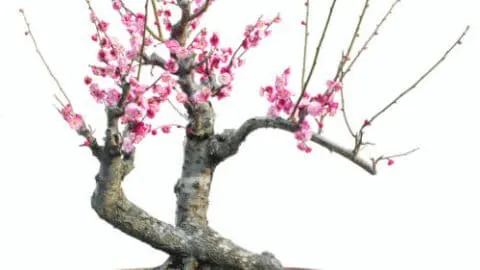In this article, I want to talk about Cherry blossom bonsai care.
The tradition of enjoying cherry trees in full bloom is an ancient custom in Japan.
When the delicate pink cherry flowers start opening at the end of March, they signify the start of the Japanese festival called Hanami, or “viewing flowers”.
Families go out to stroll under magnificent blooming cherry trees planted in parks, along the avenues, and in the countryside.
Bonsai itself is a tradition that is believed to have started with Buddhist monks in the Han and Qin Dynasties between 221 BC to 220 AD according to the University of Minnesota.
The beauty of a cherry tree in bloom is so breathtaking that it is natural that bonsai growers are making huge efforts to grow them and enjoy them every spring.
The cherry tree most commonly grown as bonsai is Japanese cherry, Prunus serrulata, but other trees from the genus Prunus can make a beautiful bonsai. When we talk about cherry blossom bonsai, we usually talk about Prunus serrulata bonsai.
Bonsai is an ancient Japanese art form that originated in China, of growing small trees in pots or trays. This art uses a special technique of growing that produces small trees that very much look like mature trees in the garden.
If you are lucky to own a cherry blossom bonsai, you will have years of pleasure enjoying its incredible blooms as long as you give it appropriate care.
Cherry blossom bonsai care
To care for a cherry blossom bonsai use bonsai soil consisting of clay particles, sand, and organic matter. Water every morning in hot summer weather and reduce watering to once a week in the colder dormant season. The ideal temperature is 32 -64 degrees Fahrenheit (0 and 18 degrees Celsius). Provide bright direct sunlight and fertilize every 2 weeks in spring and summer using a balanced fertilizer such as NPK 1-1-1.
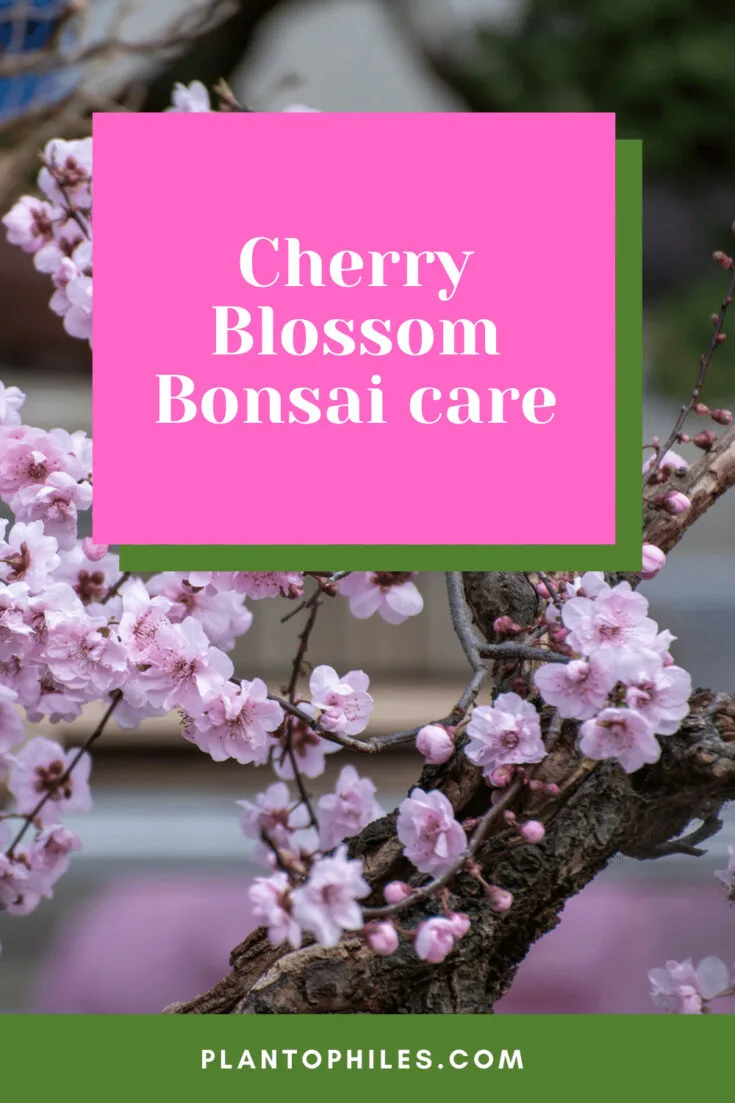
Cherry Blossom Bonsai care
Table of Contents
Cherry blossom bonsai care Guide
Caring for your cherry blossom bonsai requires a combination of knowledge for caring for a cherry tree and caring for a bonsai.
While caring for the cherry tree is not difficult, it is important to remember that it is not a house plant and cannot be grown indoors year-round. It is a living tree and it requires the same conditions to grow happily as its big cousins.
Cherry trees are native to Japan, China, and Korea, but are grown as ornamental trees in other countries with a temperate climate all over the world.
Just like its big cousins, Cherry tree bonsai has a growing season that starts after the last frost in the spring and lasts until the fall, when the tree drops its leaves and goes into a dormant period.
During the growing season, your cherry blossom bonsai needs full sun and fresh air to thrive. You can keep it indoors for special occasions, not more than a few days, to show off its beauty, especially while it is blooming.
The rest of the time, your bonsai is best kept in the garden, on the balcony, or on the deck. When it is in bloom, find a good spot at eye level to show the incredible beauty of its fragrant, pale pink, or white blossoms.
After the petals drop, they cover the soil around the tree with a stunning flower carpet. In the fall, your cherry blossom bonsai will enter a dormant period during which it does not need light and requires at least three months of cool temperature.
The best spot for it is a cool, unheated shed or a garage. Make sure that your bonsai never freezes. In the spring, put it out again.
Soil
Like other bonsai trees, your cherry blossom bonsai requires special bonsai soil. It is a course mix of clay particles, sand, and organic matter.
It is made to be very well-draining and slightly acidic. The course particles allow the root system to grow dense, able to provide the tree with all nutrients it needs in a fairly small pot.
The organic matter holds nutrients from the fertilizer to feed your tree. You can purchase the appropriate bonsai soil mix from bonsai growers.
The quality of the soil makes all the difference between having your cherry blossom bonsai thriving and blooming for 30-40 years, or not making it.
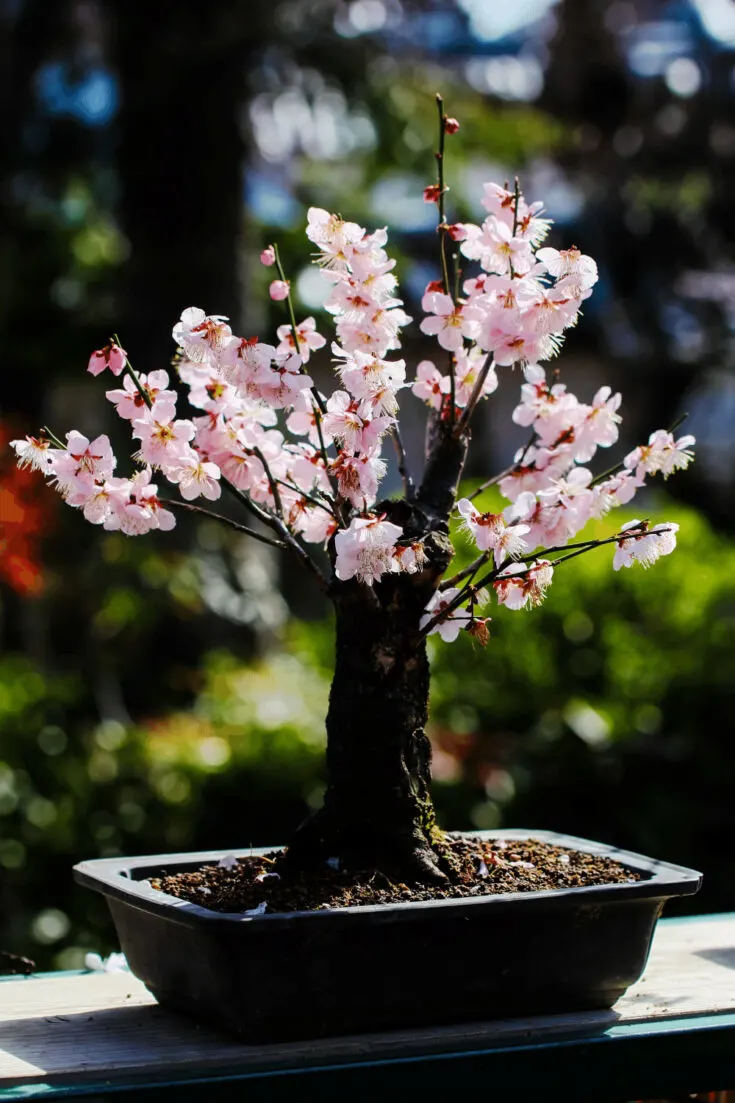
A Cherry Blossom Bonsai needs a shallow pot and bonsai soil
Watering
During the growing season, water your cherry blossom bonsai generously, until water comes out of the hole in the pot.
In the hot summer, it means watering every morning, before the sun becomes too hot.
Once the tree enters a dormant period, water it once a week, enough to ensure that the soil does not completely dry out. If your water is too hard, use filtered or distilled water.
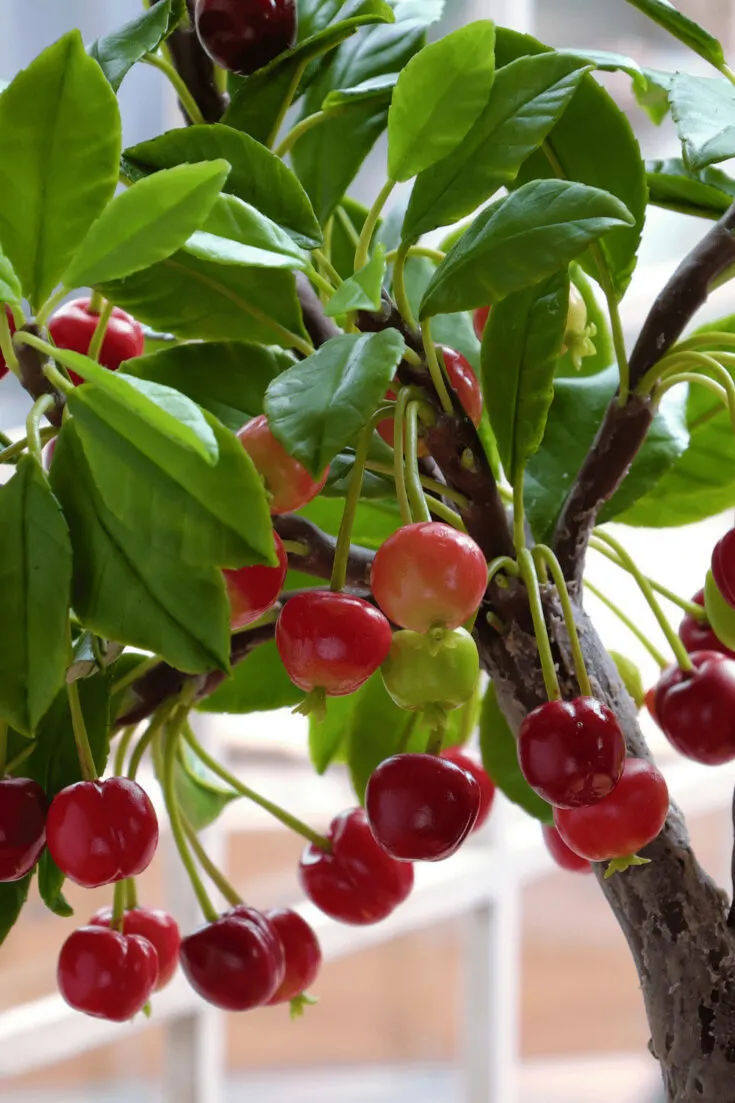
Water a Cherry Blossom Bonsai every day in the morning during hot summer days
Light
While it is growing, your bonsai will need full light and plenty of sun. A dappled shade is fine in the middle of the summer.
If you do not have a garden or a balcony, you can keep your bonsai on the window sill as long as it has plenty of sun and no draft. In the fall, when it becomes dormant, your cherry blossom bonsai will drop its leaves and will not need light anymore. You can keep it in the garage or a shed.
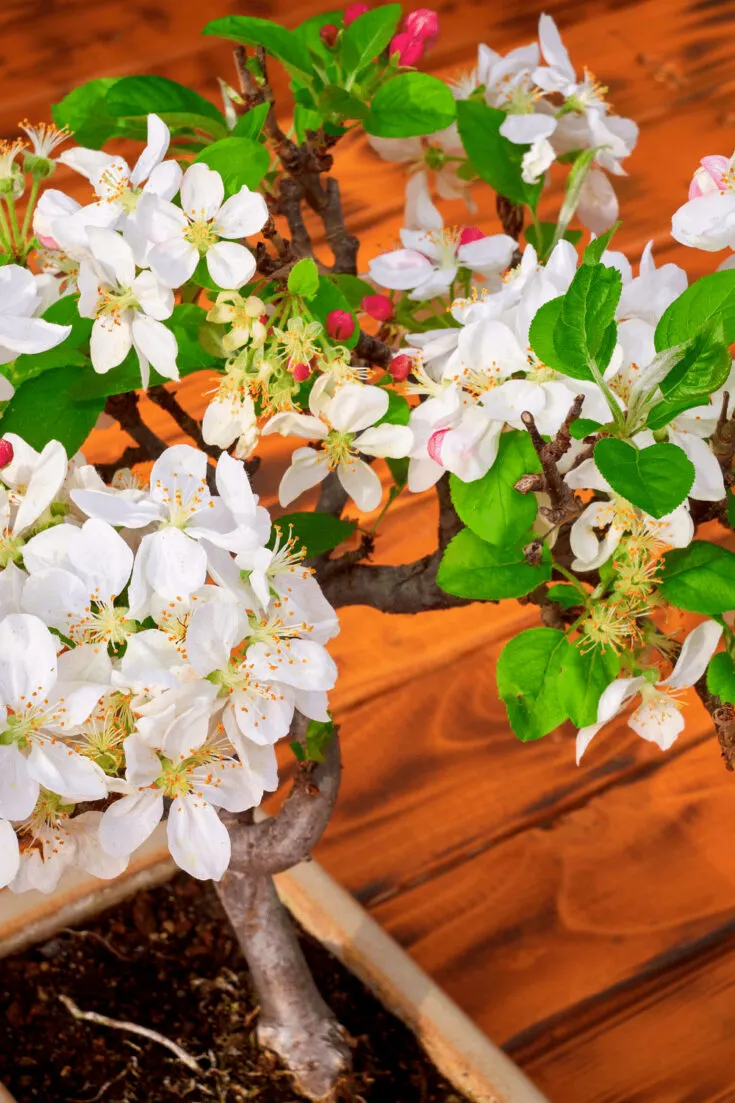
Cherry Blossom Bonsai needs bright direct light
Temperature
Cherry trees are native to countries with a temperate climate, where the average temperature is between 32 – 64 degrees Fahrenheit (0 and 18 degrees Celsius).
Your bonsai tree will enjoy warm summers and cool winters just like its big cousin. You can leave it in full sun in the summer but protect it from the frost in the winter.
Cherry blossom bonsai needs at least three months in a cool place to rest and go dormant, before coming back to life in the spring, ready to bloom.
Fertilizer
During the growing season, your cherry blossom bonsai tree needs to be fertilized every two weeks with a balanced fertilizer such as 1:1:1.
Once the tree enters a dormant period, stop fertilizing it. You can also get a special fertilizer from bonsai growers. Fertilize your bonsai only after it has been thoroughly watered to avoid burning delicate roots.
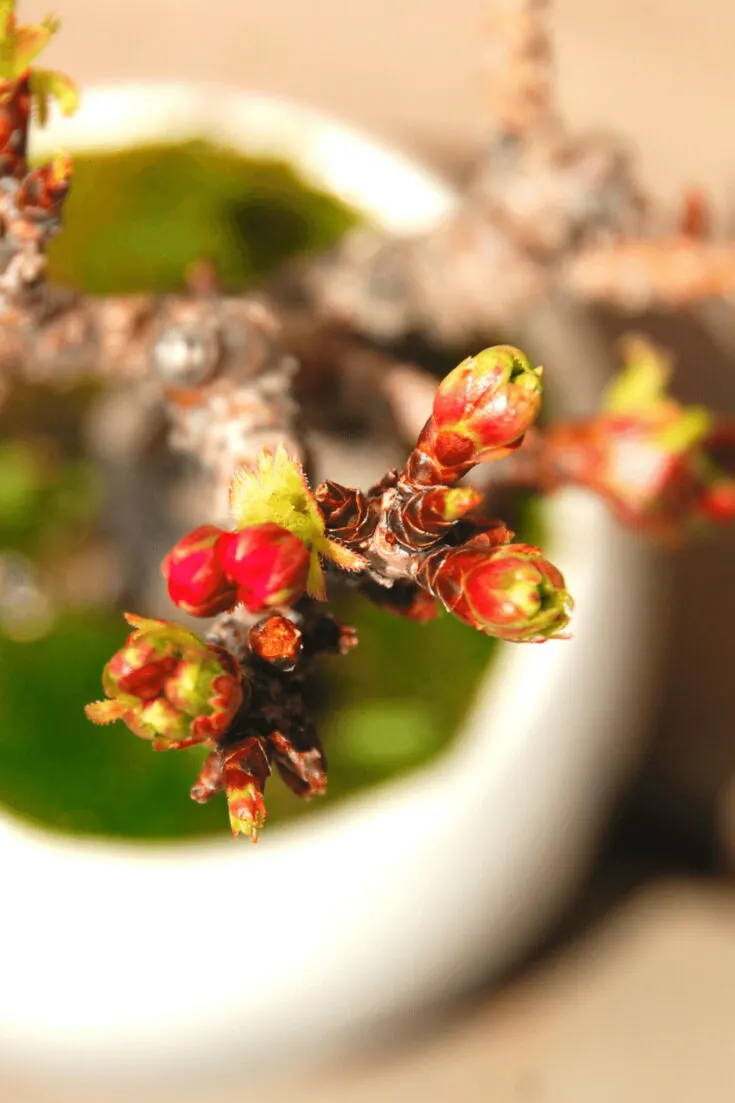
Cherry Blossom Bonsai should be fertilized every 2 weeks in spring and summer
Pots
Bonsai trees require special shallow pots, with a large drainage hole and small holes around the rim for tying the tree.
The size and shape of the pot depend on the shape and size of your tree. The pot should not be bigger than two-thirds of the size of the tree.
Its color should match or complement the color of the tree trunk. Your bonsai probably already came in the appropriate pot according to the rules of bonsai esthetics.
Bonsai pots are often pieces of art and their beauty complements the beauty of your tree.
Repotting
There are two reasons for repotting your cherry blossom bonsai tree. One is to give it fresh soil and the other is to prune its roots.
Pruning the roots is as important for keeping the size of your tree small as it is pruning its branches. If fairly large, your bonsai will probably come tied to the pot with a copper wire. Untie it, lift it and shake off the old soil.
Comb the roots with a chopstick and wash the root ball thoroughly. Trim thicker old roots and leave small feeder roots.
Trim all around the root ball to keep it balanced and allow it to be placed in the pot again. Never trim more than two-thirds of the roots.
The repotting and root pruning are best done at the end of the winter and in early spring, to allow the tree to recover before the new growth can start.
Mature trees should be repotted every two years when you see that the roots have colonized the pot, or if the tree is not thriving.
If your bonsai tree is mature, you do not need to get a bigger pot every time you re-pot it. Your goal is to keep the tree small, and you do not want to give it more space to grow.
Bonsai pots have large draining holes, which have to be covered with a mesh so that the soil does not get washed out.
After you finish trimming your roots, put a small layer of new bonsai soil at the bottom of the pot, place the tree on it and refill the rest of the pot.
Large trees will have to be tied to the pot so that they do not move and dislodge newly growing roots.
If you are new to bonsai, start with moderate root pruning until you gain confidence. Use clean, sterile cutters to avoid bacterial infection.
Wiring
Bonsai trees are wired to give them the desired form while they are growing. Use appropriate soft aluminum or copper wire around the tree branches.
Once wired, gently position the wired branch in the direction you desire. Keep a careful eye on the wires, so that they do not cut into the growing branches.
Remove the wires before it happens, in the same season you placed them. To get the idea of how to place the wired branches according to the bonsai rules, have a look at the photos of cherry blossom bonsai in various world collections for inspiration.
Pruning
Pruning or trimming your cherry blossom bonsai is necessary to keep it small and in the shape you desire. Trim the new growth in early spring, but do not trim everything or you will lose buds and your tree will not boom. You can skip trimming for a year to let the tree bloom in its full glory.
Blooms
Cherry blossoms can be, depending on the variety, white, pale pink, or pink and can be slightly fragrant. They will start opening in March and last for a few weeks. The look of the soil around the tree covered with the carpet of petals is breathtaking.
Pests
Cherry trees are prone to root rot so make sure your bonsai grows in a well-draining course medium and the draining hole is free of obstacles.
The most common pests that might bother your cherry bonsai are mites and caterpillars. If you see one crawling, pick it up by hand and keep an eye on more coming.
Spray your bonsai with an organic insecticide to prevent infestation. If things start getting out of hand, consult the local bonsai grower or the grower who sold you your cherry blossom bonsai.
Propagation
Cherry Blossom Bonsai that is blooming and looks like a mature tree is probably many years and even decades old. You can grow a new cherry tree bonsai from seeds or from a small cherry tree you can buy at the garden center.
But, it would take a very long time to get it to look like a true, beautiful cherry bonsai. Professional bonsai growers visit old cherry orchards looking for old gnarly trees that they can transform into a bonsai.
Such trees make magnificent bonsai, but it requires a lot of knowledge and experience. Growing it from a seed takes a lot of time and patience.
If you get truly passionate about bonsai, you will probably end up having many trees in different stages of growth, including tiny sprouting seeds.
Tools
If you get bitten by a bonsai bug and it becomes a hobby, you should invest in the appropriate tools for trimming and wiring your tree.
There are special cutters for trimming branches and roots, aluminum and copper wires for wiring branches, chopsticks for combing the roots, and so much more.
If you are just caring for one tree and are not planning to get more, let the local bonsai grower do your repotting every few years, wiring once a year, and trimming the new growth.
Conclusion
Cherry blossom bonsai is probably one of the most beautiful bonsai trees. But, it is not the tree for the bonsai beginners.
If you get a mature, well-shaped, healthy tree, it is fairly easy to keep it alive and blooming every year. Regular watering and fertilizing are crucial and so is keeping your tree outdoors most of the time.
Give it a few months of rest while it is dormant in the winter and it will reward you with gorgeous blooms in the spring.
While keeping your bonsai in a beautiful shape, trimming it, and repotting it might look intimidating, it can be learned by watching an expert doing it.
Find a bonsai club in your neighborhood or watch bonsai videos and you will find yourself immersed in the fascinating world of tiny trees.

Daniel has been a plant enthusiast for over 20 years. He owns hundreds of houseplants and prepares for the chili growing seasons yearly with great anticipation. His favorite plants are plant species in the Araceae family, such as Monstera, Philodendron, and Anthurium. He also loves gardening and is growing hot peppers, tomatoes, and many more vegetables.

